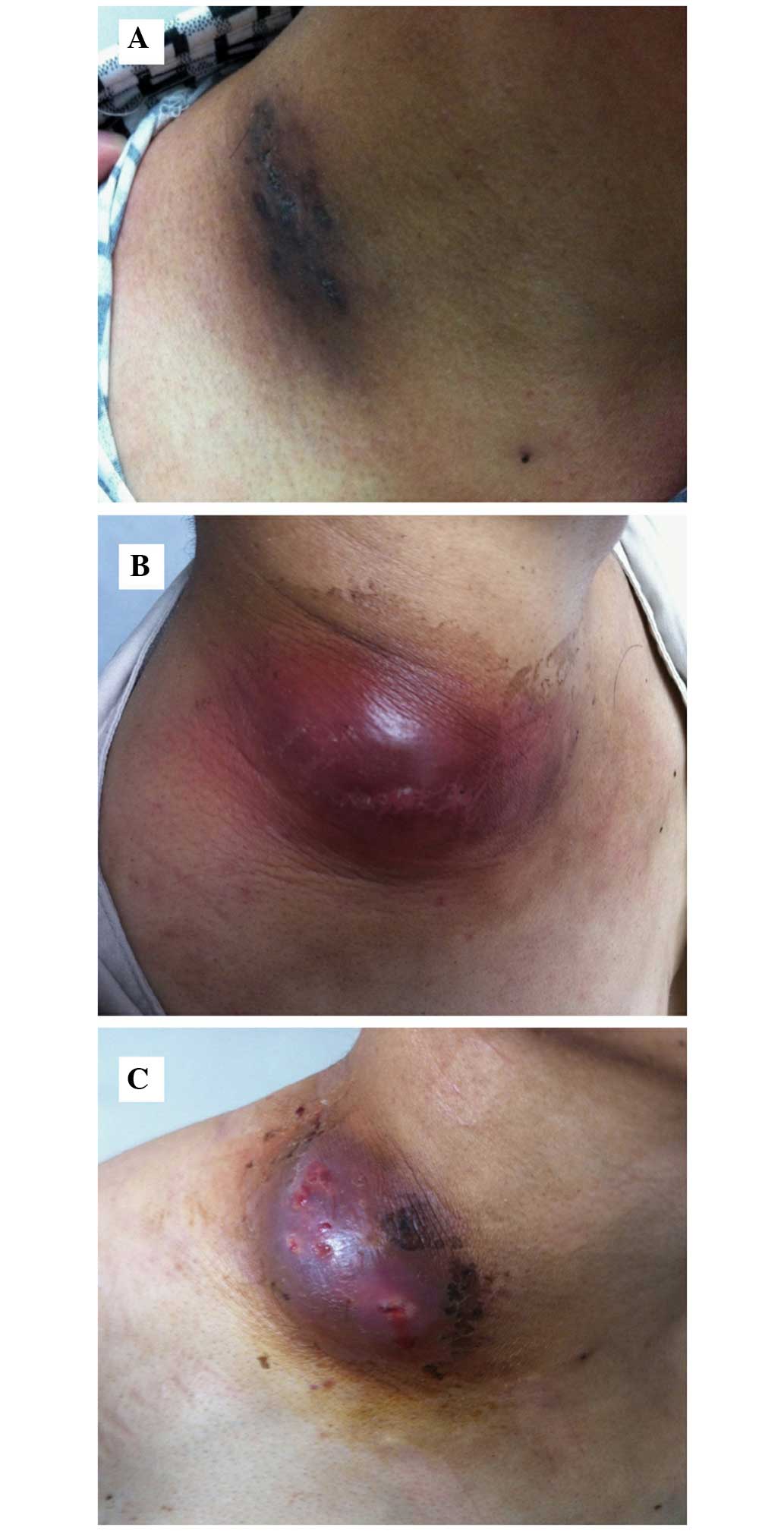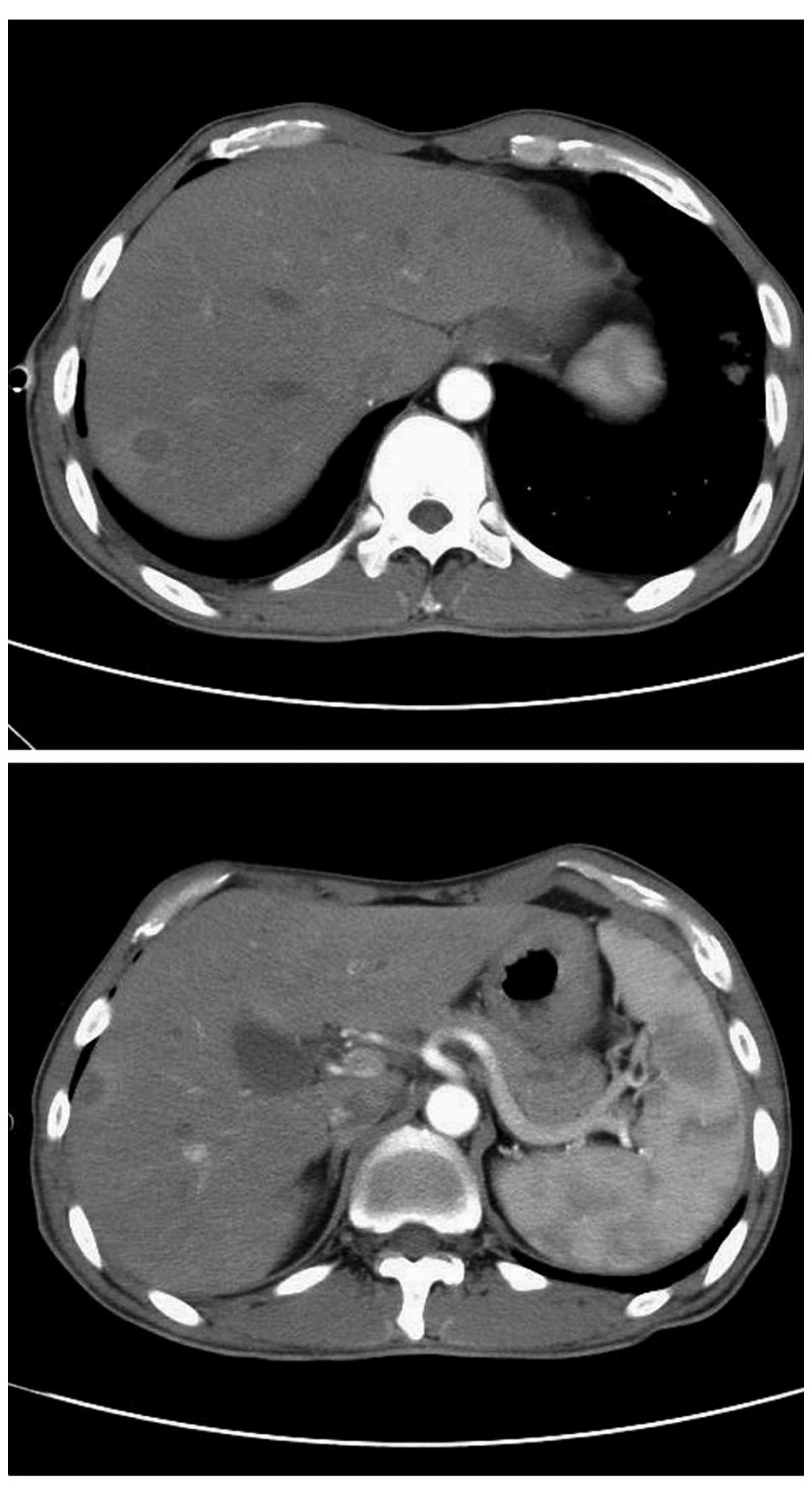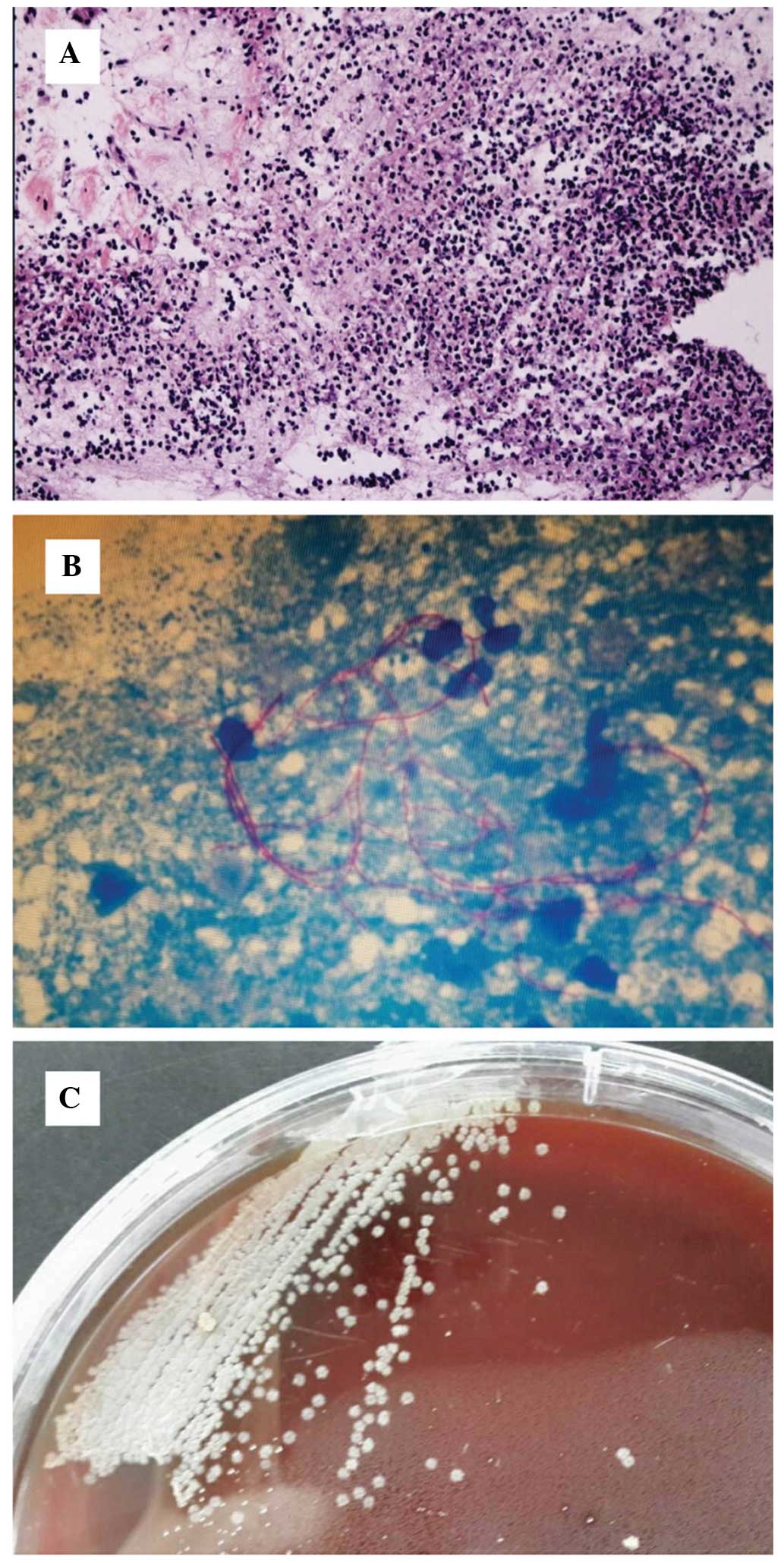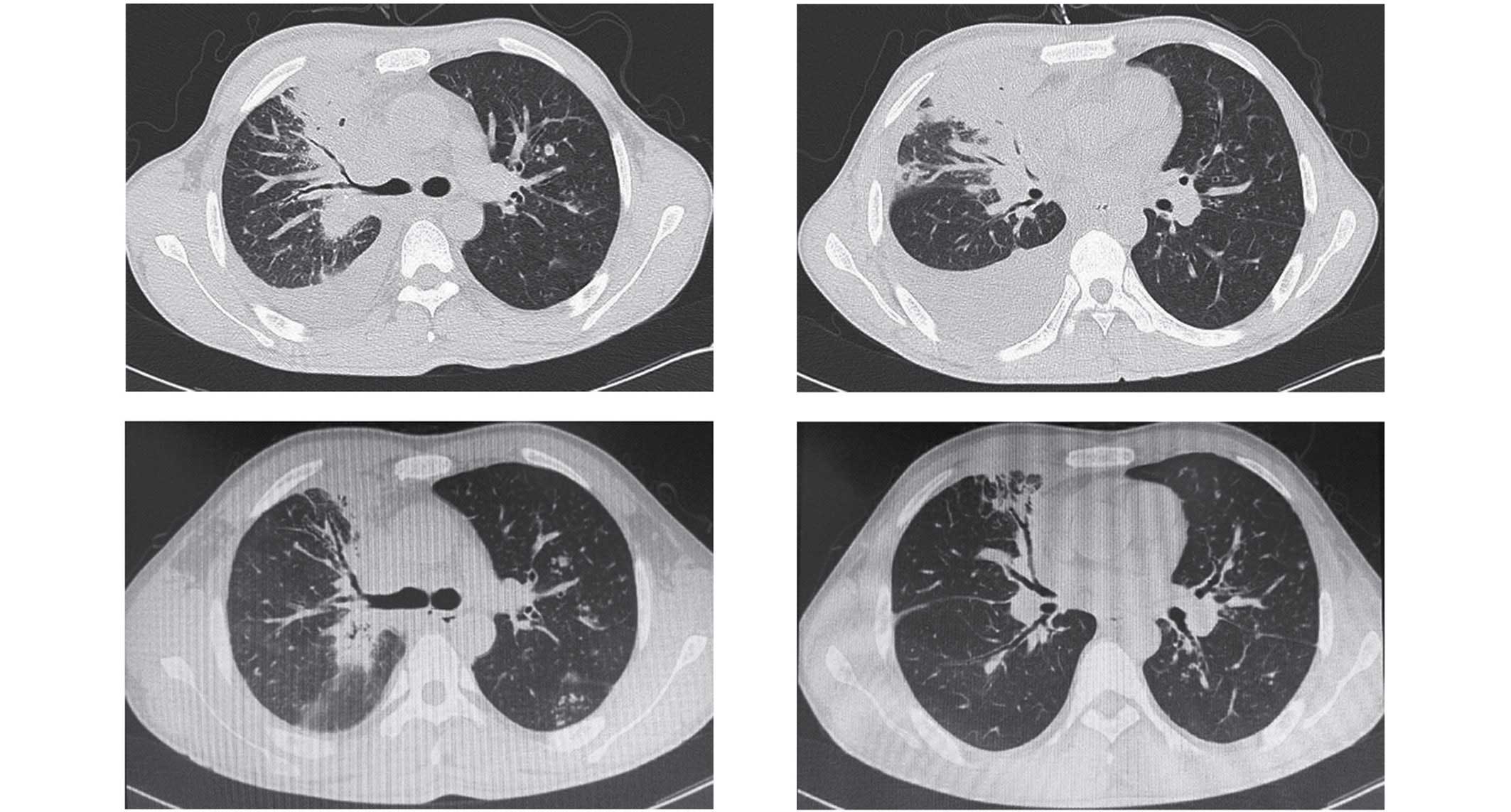|
1
|
Faghri J, Bourbour S, Moghim S, Meidani M,
Safaei HG, Hosseini N, Esfahani BN, Fazeli H and Sedighi M:
Comparison of three phenotypic and deoxyribonucleic acid extraction
methods for isolation and identification of Nocardia spp. Adv
Biomed Res. 3:151–154. 2014. View Article : Google Scholar : PubMed/NCBI
|
|
2
|
Yaşar Z, Acat M, Onaran H, Ozgü MA, Fener
N, Talay F and Cetinkaya E: An unusual case of pulmonary
nocardiosis in immunocompetent patient. Case Rep Pulmonol.
2014:9634822014.PubMed/NCBI
|
|
3
|
Shahapur PR, Peerapur BV, Shahapur RP,
Honnutagi RM and Biradar MS: Lymphocutaneous nocardiosis caused by
Nocardia otitidiscaviarum. A case report and review of literature.
J Nat Sci Biol Med. 5:197–201. 2014. View Article : Google Scholar : PubMed/NCBI
|
|
4
|
Ramamoorthi K, Pruthvi BC, Rao NR, Belle J
and Chawla K: Pulmonary nocardiosis due to Nocardia
otitidiscaviarum in an immunocompetent host - a rare case report.
Asian Pac J Trop Med. 4:414–416. 2011. View Article : Google Scholar : PubMed/NCBI
|
|
5
|
Chen B, Zhu LY, Xuan X, Wu LJ, Zhou TL,
Zhang XQ and Li BX: Isolation of both Pseudozyma aphidis and
Nocardia otitidiscaviarum from a mycetoma on the leg. Int J
Dermatol. 50:714–719. 2011. View Article : Google Scholar : PubMed/NCBI
|
|
6
|
Betrán A, Villuendas MC, Rezusta A, Moles
B, Rubio MC, Revillo MJ, Boiron P, Bello S and Rodríguez-Nava V:
Cavitary pneumonia caused by Nocardia otitidiscaviarum. Braz J
Microbiol. 41:329–332. 2010. View Article : Google Scholar : PubMed/NCBI
|
|
7
|
Pelaez AI, Garcia-Suarez MM, Manteca A,
Melon O, Aranaz C, Cimadevilla R, Mendez FJ and Vazquez F: A fatal
case of Nocardia otitidiscaviarum pulmonary infection and brain
abscess: Taxonomic characterization by molecular techniques. Ann
Clin Microbiol Antimicrob. 8:11–16. 2009. View Article : Google Scholar : PubMed/NCBI
|
|
8
|
Thoms KM, Zimmermann O, Schupp P, Thoms S
and Emmert S: Nocardia otitidiscaviarum: Cause of long-term
cutaneous abscesses on the leg of an immunocompetent man. Arch
Dermatol. 143:1086–1087. 2007. View Article : Google Scholar : PubMed/NCBI
|
|
9
|
Sharma M, Gilbert BC, Benz RL and Santoro
J: Disseminated Nocardia otitidiscaviarum infection in a woman with
sickle cell anemia and end-stage renal disease. Am J Med Sci.
333:372–375. 2007. View Article : Google Scholar : PubMed/NCBI
|
|
10
|
Fabre S, Gibert C, Lechiche C, Jorgensen C
and Sany J: Primary cutaneous Nocardia otitidiscaviarum infection
in a patient with rheumatoid arthritis treated with infliximab. J
Rheumatol. 32:2432–2433. 2005.PubMed/NCBI
|
|
11
|
Yoshida K, Bandoh S, Fujita J, Tokuda M,
Negayama K and Ishida T: Pyothorax caused by Nocardia
otitidiscaviarum in a patient with rheumatoid vasculitis. Intern
Med. 43:615–619. 2004. View Article : Google Scholar : PubMed/NCBI
|
|
12
|
Hemmersbach-Miller M, Martel AC, Benítez
AB and Sosa AO: Brain abscess due to Nocardia otitidiscaviarum:
Report of a case and review. Scand J Infect Dis. 36:381–384. 2004.
View Article : Google Scholar : PubMed/NCBI
|
|
13
|
Dikensoy O, Filiz A, Bayram N, Balci I,
Zer Y, Celik G and Ekinci E: First report of pulmonary Nocardia
otitidiscaviarum infection in an immunocompetent patient from
Turkey. Int J Clin Pract. 58:210–213. 2004. View Article : Google Scholar : PubMed/NCBI
|
|
14
|
Alberts JH and Boyd AS: Nocardia
otitidiscaviarum: An unusual Nocardia species causing a primary
lymphocutaneous infectious process in a mildly immunosuppressed
patient. Skinmed. 1:62–64. 2002. View Article : Google Scholar : PubMed/NCBI
|
|
15
|
Wada A, Matsuda S, Kubota H, Miura H and
Iwamoto Y: Primary lymphocutaneous nocardiosis caused by Nocardia
otitidiscaviarum. Hand Surg. 7:285–287. 2002. View Article : Google Scholar : PubMed/NCBI
|
|
16
|
Durán E, López L, Martínez A, Comuñas F,
Boiron P and Rubio MC: Primary brain abscess with Nocardia
otitidiscaviarum in an intravenous drug abuser. J Med Microbiol.
50:101–103. 2001.PubMed/NCBI
|
|
17
|
Hartmann A, Halvorsen CE, Jenssen T,
Bjørneklett A, Brekke IB, Bakke SJ, Hirschberg H, Tønjum T and
Gaustad P: Intracerebral abscess caused by Nocardia
otitidiscaviarum in a renal transplant patient cured by evacuation
plus antibiotic therapy. Nephron. 86:79–83. 2000. View Article : Google Scholar : PubMed/NCBI
|
|
18
|
Taniguchi H, Mukae H, Ashitani J, Ihi T,
Sakamoto A, Kohno S and Matsukura S: Pulmonary Nocardia
otitidiscaviarum infection in a patient with chronic respiratory
infection. Intern Med. 37:872–876. 1998. View Article : Google Scholar : PubMed/NCBI
|
|
19
|
Sandre RM and Summerbell RC: Disseminated
Nocardia otitidiscaviarum in a patient with AIDS. Can J Infect Dis.
8:347–350. 1997. View Article : Google Scholar : PubMed/NCBI
|
|
20
|
Mereghetti L, van der Mee-Marquet N,
Dubost AF and Boiron P: Nocardia otitidiscaviarum infection of a
traumatic skin wound. Eur J Clin Microbiol Infect Dis. 16:383–384.
1997. View Article : Google Scholar : PubMed/NCBI
|
|
21
|
Suzuki Y, Toyama K, Utsugi K, Yazawa K,
Mikami Y, Fujita M and Shinkai H: Primary lymphocutaneous
nocardiosis due to Nocardia otitidiscaviarum: The first case report
from Japan. J Dermatol. 22:344–347. 1995. View Article : Google Scholar : PubMed/NCBI
|
|
22
|
Clark NM, Braun DK, Pasternak A and
Chenoweth CE: Primary cutaneous Nocardia otitidiscaviarum
infection: case report and review. Clin Infect Dis. 20:1266–1270.
1995. View Article : Google Scholar : PubMed/NCBI
|
|
23
|
Castelli L, Zlotnik H, Ponti R and Vidotto
V: First reported Nocardia otitidiscaviarum infection in an AIDS
patient in Italy. Mycopathologia. 126:131–136. 1994. View Article : Google Scholar : PubMed/NCBI
|
|
24
|
Yang LJ, Chan HL, Chen WJ and Kuo TT:
Lymphocutaneous nocardiosis caused by Nocardia caviae: The first
case report from Asia. J Am Acad Dermatol. 29:639–41. 1993.
View Article : Google Scholar : PubMed/NCBI
|
|
25
|
Simmons BP, Gelfand MS and Roberts GD:
Nocardia otitidiscaviarum (caviae) infection in a heart transplant
patient presented as having a thigh abscess (Madura thigh). J Heart
Lung Transplant. 11:824–826. 1992.PubMed/NCBI
|
|
26
|
Snijders EP: Verslag van het
wetenschappenllijk gdeelte der vergaderingen van der afdelling
Sumatras oostkurst. Geneesk Tijdschr Ned Indie. 64:75–77. 1924.(In
Dutch).
|
|
27
|
Ferreira NP and Tracey RP: Numerical
taxonomy of cholesterol-degrading soil bacteria. J Appl Microbiol.
57:429–446. 2008.
|
|
28
|
Goodfellow M, Kämpfer P, Busse HJ,
Trujillo ME, Suzuki KI, Ludwig W and Whitman WB: The
ActinobacteriaBergeys Manual of Systematic Bacteriology. 5. 2nd.
Springer; New York, NY: 2012, View Article : Google Scholar
|
|
29
|
Gomez-Flores A, Welsh O, Said-Fernández S,
Lozano-Garza G, Tavar-Alejandro RE and Vera-Cabrera L: In Vitro and
In Vivo Activities of Antimicrobials against Nocardia brasiliensis.
Antimicrob Agents Chemother. 48:832–837. 2004. View Article : Google Scholar : PubMed/NCBI
|
|
30
|
Brown-Elliott BA, Brown JM, Conville PS
and Wallace RJ Jr: Clinical and laboratory features of the Nocardia
spp. based on current molecular taxonomy. Clin Microbiol Rev.
19:259–282. 2006. View Article : Google Scholar : PubMed/NCBI
|
|
31
|
Schaal KP and Lee HJ: Actinomycete
infections in humans: A review. Gene. 115:201–211. 1992. View Article : Google Scholar : PubMed/NCBI
|
|
32
|
Duran E, Lopez L, Martinez A, Comuñas F,
Boiron P and Rubio MC: Primary brain abscess with Nocardia
otitidiscaviarum in an intravenous drug abuser. J Med Microbiol.
50:101–103. 2001.PubMed/NCBI
|
|
33
|
Tan CK, Lai CC and Lin SH: Clinical and
microbiological characteristics of Nocardiosis including those
caused by emerging Nocardia species in Taiwan, 1998–2008. Clin
Microbiol Infect. 16:966–972. 2010. View Article : Google Scholar : PubMed/NCBI
|
|
34
|
Mari B, Montón C and Mariscal D: Pulmonary
nocardiosis: Clinical experience in ten cases. Respiration.
68:382–388. 2001. View Article : Google Scholar : PubMed/NCBI
|
|
35
|
Miralles GD: Disseminated Nocardia
farcinica infection in an AIDS patient. Eur J Clin Microbiol Infect
Dis. 13:497–500. 1994. View Article : Google Scholar : PubMed/NCBI
|
|
36
|
McNeil MM and Brown JM: The medically
important aerobic actinomycetes: Epidemiology and microbiology.
Clin Micmbiol Rev. 7:357–417. 1994. View Article : Google Scholar
|
|
37
|
Zhang W, Peng GJ, Liu J, Hu H and Liang H:
Identification of rare Nocardia otitidiscaviarum and its drug
sensitivity analysis. Int J Lab Med. 35:1320–1325. 2014.
|


















